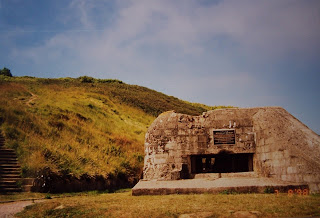The entrance to the tunnel system. Defended by what appears to be the dug in turret of a Panther Tank. The entrance is to the right, behind the trees.
Covering the entrance inside the bunker is a MG inside a small booth.
The are a couple of these compartments in which you can also appreciate the details of everyday life for the men living there.
The radio set inside another such watch post.
Once you are inside the tunnels, one side is lined up with all sorts of vehicles. As you can appreciate, the tunnels are quite wide and long.
A US 2 1/2 Ton Cargo truck, also known as Deuce and a Half or Jimmy.
A German Sd Kfz 251. Hard for me to tell which if the Halftrack variations it is.
An Opel German car. From its color it seems like it might have been used as a staff car.
US M3 Halftrack
German 88mm Anti-Aircraft gun mounted on its carriage.
German Kettenkrad.
Remember Saving Private Ryan?
Looks like a German Zündapp KS 750 with sidecar.
From the license plate, it looks like this one belonged to the SS.
German Kubelwagen.
US M3 Scout car.
This vehicle was the basis for the M3 Halftrack.
US Willys Jeep
German PAK 40
Interesting mount for what appears to be a 75mm Tank Gun.
I suspect it's setup this way just for display. I don't see how such a mount could handle the recoil.
German Opel Blitz (Sd Kfz 305) Cargo Truck
Some exploded and unexploded bombs.
At some point you reach the end of the tunnels that are 'finished' and a fence prevents you from continuing on to the 'unfinished' section.
In a special room dug into the side of the tunnel you run into this quadruple 20mm Anti-Aircraft gun. A sheet of thick plexiglass made it hard to get a sharp picture...
German SS mountain trooper.
All sorts of small arms are on display.
Note the padding on the MG tripod to make it easier to carry over the shoulder.
Most interesting here is the rangefinder to the left of the SS trooper.
A German MG setup on a tripod could be used in an Anti-Aircraft role.
US trooper and motorbike.
Nice opportunity to see the German infantryman's uniform in detail.
German longcoat.
US 50 cal machine gun.
US Tommy gun, US flamethrower and mortar.
Multiple gas mask models. I guess WWI left them quite concerned (justifiably so!) about chemical weapons.
Another set of German weaponry. Notice the Sturmgewehr (Stg44) on the left and the MP40 (Maschinenpistole) on the right.
A good variety of German helmets.
And some more...
Some medals and military insignia
A 'cave' full of unexploded ordnance
These are items that were found on an excavation next to a road. A German column had been bombed by an American dive bomber and all the debree had been pushed aside and hastily buried only to be discovered recently.
A couple of US tanks stand guard at the Museum's entrance/exit. The one in the back seems like a M41 Walker Bulldog light tank. That was a post WWII design, so it's not clear to me what it's doing in this Museum. I guess it was left over from the occupation and somebody thought this was a good place to park it :-) Anyhow, this is the parting view as you leave the museum. Hope you found it as interesting as I did.
Click here to see a post about the West Wall museum at Bad Bergzabern
Click here to see a post about the US Airborne museum at Fayetville
Click here to see a post about the British Airborne museum at Arnhem
Click here to see a post about the rocket museum at Peenemunde
Click here to see a post about the Auto and Technik museum at Sinsheim
Click here to see a post about the Normandy Landing Beaches















































































